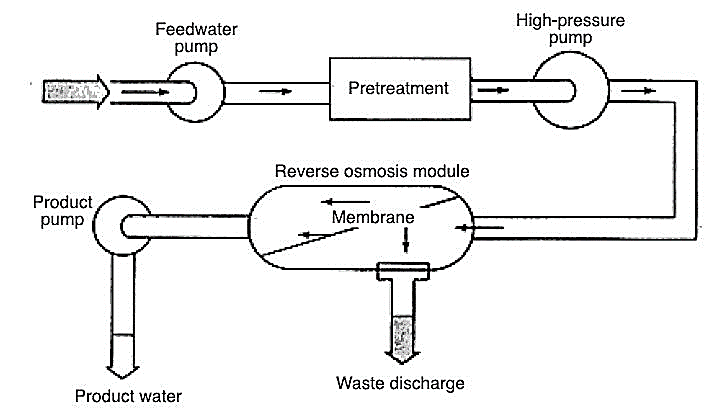
Seawater Desalination with Reverse Osmosis Plant
All Reverse Osmosis vegetation are essentially Desalination Vegetation but desalination is being referred to sea water Commonly.As sea h2o has extremely substantial TDS requires extremely substantial tension to drive sea water by means of membranes which might be different then brackish water membranes.
Reverse Osmosis Plant Particulars:
A reverse osmosis plant can be a production plant, wherever h2o is purified and desalinated by forcing h2o via a membrane, commonly known as a reverse osmosis process. Water made by plant RO may very well be useful for several purposes like desalination, wastewater treatment, and also the reclamation of dissolved minerals.
RO Plant Description
An average ingesting drinking water RO plant technique calls for six KW several hours of energy to desalinate a person cubic meter of drinking water. Reverse osmosis water crops necessitates a range of pre-treatment method tactics which includes softening, DE chlorination, and anti-scale therapy. Next pre-cure, substantial levels of force ship h2o by way of a semi-permeable membrane, which retains all contaminants other than water.
RO Plant Style and design
To boost the performance and life of the Reverse Osmosis plant, helpful pretreatment on the feed water is needed. Choice of the ideal pretreatment will increase performance and membrane lifestyle by lessening:
Fouling
Scaling
Membrane Degradation
RO plant design and style is consisting of:
Pinpointing pretreatment necessity of Reverse Osmosis Plant
If your feed water has traces of weighty metals, it is very suggested to dose some chlorine to alter the dissolved major metals to physical kind, the media filter will filter most of it within a ro h2o purifier plant.
Reverse Osmosis Plant Selection of membrane
Membrane factors are a significant part of RO plants. The proteins (largely polyamide) that make-up membrane things change with regards to the ending clarity and consumption drinking water seawater or brackish drinking water etcetera
Waterman engineers Australia RO plant for seawater desalination
Waterman Engineers in Australia has designed a Reverse Osmosis (RO) plant for seawater desalination, which provides numerous rewards about other desalination procedures. Below are a few vital great things about their RO plant:
Electrical power Performance:
Compared to other desalination techniques like thermal distillation, RO requires less energy. Waterman Engineers' RO plant makes use of Highly developed membrane technological know-how, allowing for it to work at decrease pressures and minimize General energy use.
Environmental Impression:
RO generates considerably less brine discharge in comparison with thermal techniques, reducing the effect on marine ecosystems. This aligns with Australia's deal with environmental sustainability and conservation.
Substantial Water Purity:
The RO course of action efficiently gets rid of salts, minerals, and impurities, making higher-high-quality freshwater that fulfills stringent ingesting water criteria. This reliability is important for offering Harmless and thoroughly clean h2o to communities.
Modular Style:
Waterman Engineers' RO plant employs a modular style and design, permitting for scalability and suppleness. This is especially advantageous for places with different h2o demands, as modules might be included or adjusted accordingly.
Diminished Footprint:
RO crops generally Possess a more compact Actual physical footprint compared to thermal desalination plants, which often call for considerable infrastructure for heating and cooling procedures.
Quick Commence-Up and Shutdown:
RO vegetation might be started off and stopped rather quickly, permitting for far better responsiveness to shifting drinking water needs and emergencies.
Reduced Chemical Utilization:
As opposed to Various other desalination approaches, RO calls for less chemical substances for operation and cleansing, reducing chemical-connected environmental considerations.
Consistency in Overall performance:
The RO process is less delicate to feedwater good quality fluctuations than other approaches, making certain a far more reliable functionality with time.
Price-Effectiveness:
When Preliminary expense prices might be considerable, RO crops have a tendency to have decreased operational and upkeep prices Eventually in comparison to thermal solutions.
Reverse Osmosis (RO) is actually a h2o purification method that takes advantage of a partially permeable membrane to get rid of ions, unwelcome molecules, and larger particles from consuming h2o. By implementing stress to beat osmotic tension, it permits the passage of h2o molecules while rejecting contaminants, thereby manufacturing clean water on one particular facet of the membrane and concentrated impurities on another.
The Doing work basic principle of the Reverse Desalination Plant Manufacturer Osmosis (RO) plant involves applying strain to your saline Alternative to force water molecules through a semi-permeable membrane. This membrane permits only drinking water to move even though rejecting salts, contaminants, and impurities, leading to purified drinking water to the permeate facet in addition to a concentrated solution of contaminants around the brine side.
The advantages of Reverse Osmosis consist of creating large-top quality, thoroughly clean water by removing contaminants, becoming efficient and price-helpful eventually, demanding nominal chemical use, and getting adaptable to various scales of Procedure from smaller property techniques to huge municipal plants.
RO vegetation have replaced Demineralisation (DM) crops as they typically supply a more successful and cost-effective Option for drinking water purification. RO systems Really don't demand the regeneration chemical compounds that resin-based DM plants do and might eliminate a broader number of contaminants, like dissolved solids and microorganisms.
Waterman Engineers Australia likely works by using Reverse Osmosis (RO) plants for seawater desalination by forcing seawater by way of a semi-permeable membrane to eliminate salt and also other impurities. This method creates contemporary, potable water through the ocean, addressing h2o scarcity and offering a sustainable offer for numerous demands.